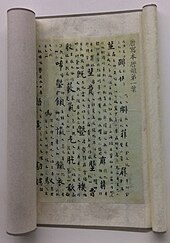This article should specify the language of its non-English content, using {{lang}}, {{transliteration}} for transliterated languages, and {{IPA}} for phonetic transcriptions, with an appropriate ISO 639 code. Wikipedia's multilingual support templates may also be used. (October 2023) |

A rime dictionary, rhyme dictionary, or rime book (traditional Chinese: 韻書; simplified Chinese: 韵书; pinyin: yùnshū) is a genre of dictionary that records pronunciations for Chinese characters by tone and rhyme, instead of by graphical means like their radicals. The most important rime dictionary tradition began with the Qieyun (601), which codified correct pronunciations for reading the classics and writing poetry by combining the reading traditions of north and south China. This work became very popular during the Tang dynasty, and went through a series of revisions and expansions, of which the most famous is the Guangyun (1007–1008).
These dictionaries specify the pronunciations of characters using the fanqie method, giving a pair of characters indicating the onset and remainder of the syllable respectively. The later rime tables gave a significantly more precise and systematic account of the sounds of these dictionaries by tabulating syllables by their onsets, rhyme groups, tones and other properties. The phonological system inferred from these books, often interpreted using the rime tables, is known as Middle Chinese, and has been the key datum for efforts to recover the sounds of early forms of Chinese. It incorporates most of the distinctions found in modern varieties of Chinese, as well as some that are no longer distinguished. It has also been used together with other evidence in the reconstructions of Old Chinese.
Some scholars use the French spelling rime, as used by the Swedish linguist Bernard Karlgren, for the categories described in these works, to distinguish them from the concept of poetic rhyme.[1]
- ^ Branner (2006), p. 2.